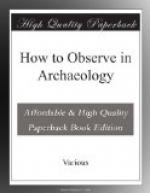The Periods into which the subject must be divided
are roughly as
follows:
I. Prehistoric down
to about 1000 B.C.
II. Prehistoric Greek
down to about 700 B.C.
III. Archaic Greek 700-500
B.C.
IV. Classical Greek
500-300 B.C.
V. Hellenistic after
300.
VI. Roman.
VII. Byzantine.
I. PREHISTORIC
A. NORTH GREECE.
Neolithic.—Neolithic settlements on low mounds (maghoules) rising from the plains.
Stone implements. Axes, hammers, chisels, querns, &c. Flint chips, bone needles, obsidian.
Pottery. Hand-made burnished, yellow, brown, black or red. Handles rare. Holes in rim, or lugs pierced for suspension, Earliest remains show painted sherds. Long period of unpainted ware followed. Patterns irregular, rectangular and curved. No naturalism. (Figs. 1 and 2.)
Ware differs slightly with locality. In Thessaly fine red ware undecorated contemporary with red decoration on white. Chocolate paint on deep buff follows. Incised ware, geometric patterns white rubbed in.
Figurines.
Rude clay. Steatopygous.
This civilization extended from northern edge of Thessaly as far south as Chaeronea. Use of bronze before end uncertain. Civilization undisturbed by Aegean culture that spread over southern Greece until just before both were swept away by iron-using people.
B. CRETE, AEGEAN, SOUTH GREECE.
Crete.
Neolithic.
Black or red burnished pottery.
Bronze age.
Early Minoan.
Painted pottery, dark paint on light ground, geometric
designs.
Unpainted, surface mottled red and black.
Middle Minoan. circa. 3000 B.C.—White designs geometric on dark ground. Orange and crimson added. Pottery very thin and fine (Kamares ware). Patterns very various but not naturalistic except in rare instances. (Figs. 3 and 4; hatched lines=red.)
Late Minoan. circa. 1500 B.C.—Return to use of light ground. Brown lustrous paint, fine surface to clay. Decoration naturalistic, flowers, cuttle-fish, shells, spirals, ripple patterns, white and orange dots and bands occasionally super-imposed on dark glaze (Figs. 7, 10, and 12).
White and orange disappear. Decoration stiffer and more conventional.
AEGEAN.
Neolithic. Nothing known.
Bronze age.
Contemporary with Early Minoan.
Pottery with geometric patterns normally dark on light buff or reddish coarse clay. Sometimes red or white on black burnished clay.
Marble figurines ‘fiddle-shaped’ from Naxos and Paros (III, Fig. 6).
Contemporary with Middle Minoan.
Pottery with very pale sometimes greenish clay, and grey black totally unlustrous paint. Patterns mainly geometric. Rather sparse decoration. Later, with addition of red, decoration becomes fully naturalistic. Lilies and birds in red and black (Melos) (III, Figs. 5 and 9; hatched lines=red). Beaked jugs (III, Fig. 5) most characteristic shape of this period.




